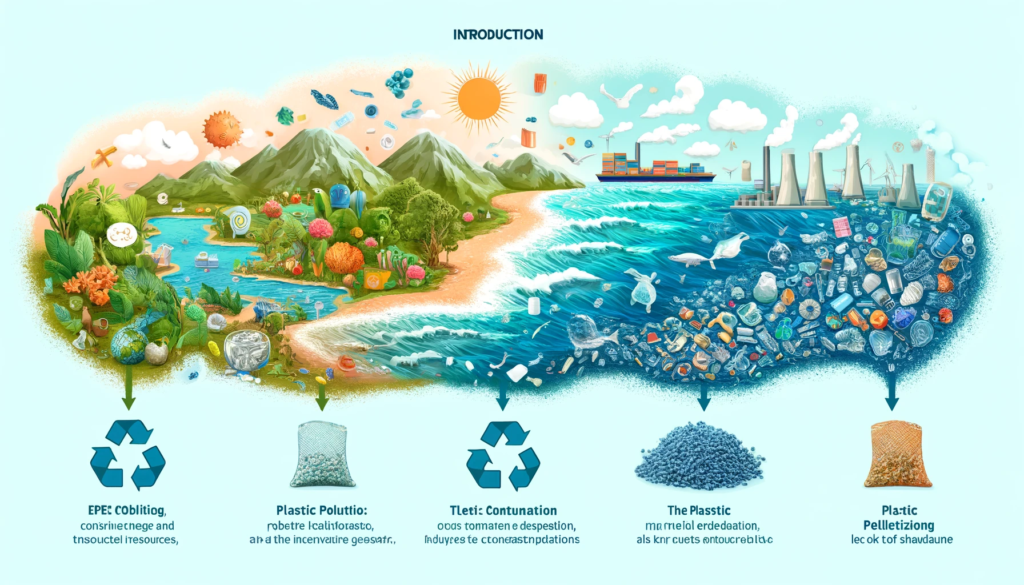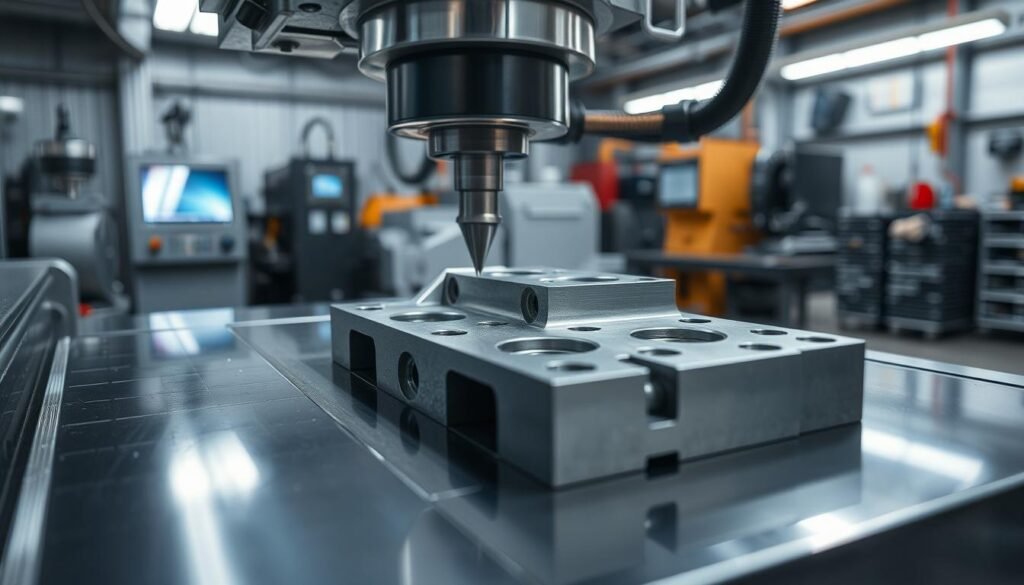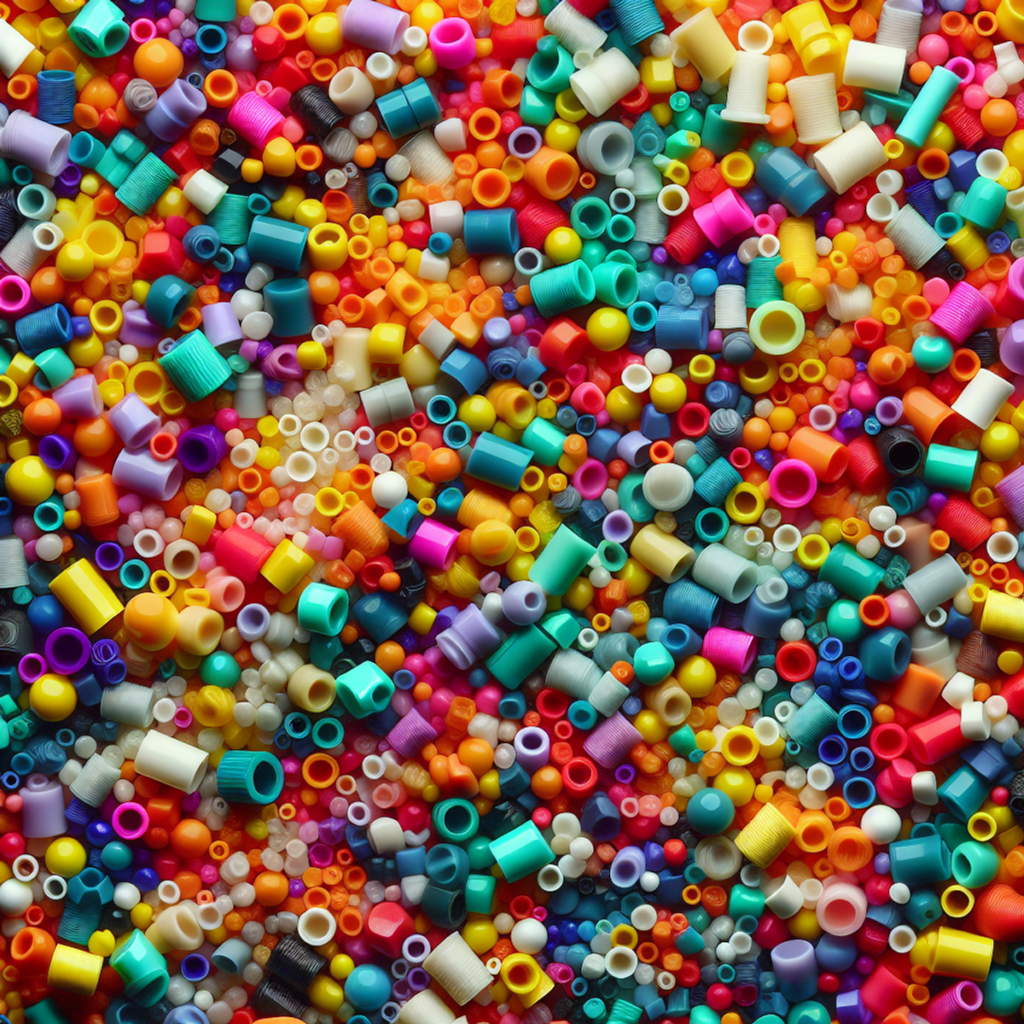Introduction: Plastic Pollution and Recycling
Plastic Pollution: A Global Environmental Problem
Damaging Ecosystems
Plastic waste accumulates in natural habitats, harming wildlife through entanglement, ingestion, and habitat degradation. Marine ecosystems are particularly vulnerable, with plastic debris affecting countless species, from plankton to whales.
Threatening Human Health
Microplastics, derived from the breakdown of larger plastic items, contaminate food chains and water sources. These tiny particles can carry toxic chemicals and are ingested by humans, potentially leading to health issues such as hormonal disruption and cancer.
Plastic Recycling: A Crucial Means to Reduce Plastic Waste
Conservation and Resource Efficiency
Recycling plastic materials helps to conserve resources, reduce energy consumption, and minimize the amount of plastic waste ending up in landfills and the environment. By transforming used plastics into new products, recycling extends the life cycle of the material and decreases the demand for virgin plastics.
Plastic Pelletizing: A Key Step in the Recycling Process
Defining Plastic Pelletizing and Its Role
Plastic pelletizing is the process of converting recycled plastic materials into small, uniform pellets. These pellets serve as raw materials for manufacturing new plastic products. Pelletizing ensures consistent quality and makes the recycled plastic easier to handle, transport, and process.
Current Limitations of Plastic Pelletizing Technologies
Despite its importance, plastic pelletizing faces several challenges that hinder its effectiveness in addressing the plastic waste problem:
- Contamination: Recycled plastic often contains impurities such as labels, adhesives, and other debris, which can compromise the quality of the pellets and the final products.
- Material Degradation: Plastics can degrade during the recycling process due to heat, moisture, and exposure to chemicals, resulting in pellets with reduced mechanical properties and limited application potential.
- Lack of Standardization: The wide variety of plastic types and grades makes it difficult to establish universal pelletizing standards, leading to inconsistencies in pellet quality and compatibility issues during subsequent manufacturing processes.
- High Energy Consumption: Pelletizing machines often require significant amounts of energy to operate, increasing the overall environmental footprint of the recycling process and making it less economically viable.
These limitations underscore the need for innovative solutions in plastic pelletizing technologies to enhance their efficiency, versatility, and sustainability, ultimately contributing to a more effective plastic recycling system and a cleaner environment.

Presenting the Problem
Core question: How can plastic pelletizing machines be innovated to better serve plastic recycling?
The success of plastic recycling heavily depends on the efficiency and effectiveness of the pelletizing process. To address the current limitations and enhance the overall recycling system, it is crucial to explore ways to revolutionize plastic pelletizing machines. This core question aims to identify the key areas where technological advancements can be made to improve the performance, versatility, and sustainability of pelletizing equipment.
Potential aspects to consider include:
- Developing advanced sorting and cleaning mechanisms to minimize contamination and ensure high-quality pellets.
- Implementing gentler processing methods to reduce material degradation during pelletizing.
- Designing modular and adaptable machines to handle a wide range of plastic types and grades, promoting standardization.
- Integrating energy-efficient technologies to reduce the environmental impact and operating costs of pelletizing.
By focusing on these aspects, researchers and engineers can work towards creating innovative pelletizing solutions that overcome current challenges and optimize the recycling process.
Research objective: Improving plastic pelletizing through technological innovation to change the environmental impact of plastic waste
The primary goal of this research is to develop cutting-edge plastic pelletizing technologies that significantly enhance the efficiency, quality, and versatility of the recycling process. By creating advanced pelletizing machines that can handle a wide range of plastic materials, minimize contamination, and produce high-quality pellets, we aim to increase the overall recycling rates and reduce the amount of plastic waste entering the environment.
Specific objectives include:
- Conducting a comprehensive analysis of existing pelletizing technologies and their limitations to identify areas for improvement.
- Developing and testing innovative designs, components, and processes that address the identified challenges and optimize pelletizing performance.
- Evaluating the environmental impact of the new pelletizing technologies, considering factors such as energy consumption, greenhouse gas emissions, and waste reduction.
- Promoting the adoption of the improved pelletizing machines in the recycling industry through collaboration with stakeholders and demonstrating their economic and ecological benefits.
By achieving these objectives, the research aims to contribute to a more sustainable and effective plastic recycling system, ultimately leading to a significant reduction in plastic pollution and its detrimental effects on the environment and human health. The innovative pelletizing technologies developed through this research will serve as a critical step towards creating a circular economy for plastics and mitigating the global plastic waste crisis.

Literature Review
Existing plastic pelletizing technologies and their applications
A thorough examination of the current state of plastic pelletizing technologies is essential to understanding their strengths and weaknesses. This section will provide an overview of the most common pelletizing methods, such as strand pelletizing, underwater pelletizing, and hot-cut pelletizing, discussing their working principles, suitable plastic types, and application areas. Additionally, the review will cover the latest advancements in pelletizing technologies, including high-speed pelletizers, micro-pelletizers, and multi-material pelletizing systems, highlighting their unique features and potential benefits for recycling.
Previous improvement proposals for pelletizing machines
Researchers and industry experts have put forward various ideas to enhance the performance and efficiency of plastic pelletizing machines. This section will summarize the most notable improvement proposals, such as:
- Incorporating advanced sorting technologies, like near-infrared (NIR) spectroscopy, to automatically separate different plastic types and remove contaminants before pelletizing.
- Implementing continuous melt filtration systems to remove impurities and improve pellet quality.
- Optimizing the pelletizing process parameters, such as temperature, pressure, and cutting speed, to minimize material degradation and energy consumption.
- Developing modular and flexible pelletizing lines that can quickly adapt to different plastic materials and production requirements.
By analyzing these proposals, the review will provide insights into the current research trends and the potential directions for future innovations in pelletizing technologies.
Limitations of existing technologies and improvement proposals
Despite the advancements in plastic pelletizing, there are still significant limitations that hinder their effectiveness in addressing the plastic waste problem. This section will critically evaluate the shortcomings of current technologies and the challenges in implementing the proposed improvements:
- Inadequacies in processing mixed plastic waste Many pelletizing machines struggle to handle the heterogeneous nature of post-consumer plastic waste, which often contains a mix of different plastic types, colors, and contaminants. The review will discuss the difficulties in achieving consistent pellet quality and the need for more advanced sorting and cleaning technologies.
- Inadequacies in processing degraded plastics Recycled plastics often exhibit reduced mechanical properties due to degradation caused by repeated processing, exposure to environmental factors, and the presence of additives. This section will highlight the limitations of current pelletizing technologies in dealing with degraded plastics and the need for innovative solutions to restore material properties.
- Potential challenges in practical application Implementing the proposed improvements in real-world pelletizing operations may face several obstacles, such as high investment costs, technical complexity, and the need for skilled personnel. The review will discuss these practical challenges and emphasize the importance of developing cost-effective, user-friendly, and scalable solutions.
By critically analyzing the limitations of existing technologies and improvement proposals, this literature review will set the stage for the development of innovative pelletizing solutions that can effectively address the challenges in plastic recycling and contribute to a more sustainable future.
Research Process
Our Team’s Practical Experience in Developing a New Plastic Pelletizing Machine
1. Conceptualization and Prototyping
- Discuss the iterative process of conceptualizing the new pelletizing machine.
- Detail the steps involved in prototyping, including material selection and the development of key components.
2. Testing and Optimization
- Highlight the testing phase, focusing on optimizing process parameters to achieve desired pelletizing performance and pellet quality.
- Mention specific tests conducted and adjustments made to improve the machine’s efficiency.
Difficulties Encountered and Failed Attempts During Experiments
1. Challenges Faced
- Inconsistent pellet size and shape due to suboptimal cutting mechanisms.
- Insufficient contaminant removal leading to reduced pellet purity.
- Excessive energy consumption and overheating of machine components.
- Difficulties in processing certain types of degraded or mixed plastic waste.
2. Analysis of Setbacks
- Provide a candid discussion of these challenges and how they impacted the research process.
Lessons Learned from Failures
1. Key Takeaways
- Importance of robust and precise cutting systems for achieving consistent pellet size and shape.
- Need for effective pre-processing and filtration techniques to remove contaminants and improve pellet quality.
- Significance of optimizing energy efficiency and thermal management to reduce operational costs and environmental impact.
- Necessity of developing flexible and adaptable solutions to handle a wide range of plastic waste types.
2. Application of Lessons Learned
- Describe how these lessons informed subsequent research efforts and design improvements.
The Eureka Moment: Key Insights and Innovative Design Concepts
1. Emergence of Revolutionary Design Ideas
- Recount pivotal moments of gaining critical insights that led to breakthroughs.
- Describe novel ideas generated for overcoming limitations of existing pelletizing technologies.
2. Core Principles of the New Design
- Advanced sorting and cleaning mechanisms for effective contaminant removal.
- Gentle pelletizing process to minimize material degradation.
- Modular and flexible architecture to handle diverse plastic types and grades.
- Energy-efficient components and optimized process parameters for reduced environmental impact.
3. Innovative Features
- Highlight unique features of the new design and how it addresses specific challenges.
- Explain the overall benefits of the new machine in enhancing plastic recycling and reducing plastic waste.

Research Outcomes
Detailed Introduction of the New Plastic Pelletizing Machine
Working Principles
In this subsection, we will provide a comprehensive overview of our innovative plastic pelletizing machine, focusing on its working principles. We will explain how the machine integrates advanced sorting, cleaning, and pelletizing technologies to efficiently process mixed and degraded plastic waste. The description will cover the step-by-step process, from the initial feeding of plastic waste to the final output of high-quality pellets. We will also highlight how our design incorporates smart sensors, control systems, and feedback loops to optimize the pelletizing process in real-time, ensuring consistent pellet quality and minimizing material degradation.
Technological Advantages
Building upon the working principles, we will discuss the key technological advantages of our new pelletizing machine compared to existing solutions. This will include:
- Enhanced Contaminant Removal Efficiency: Advanced sorting and cleaning mechanisms.
- Minimized Material Degradation: Gentle pelletizing process and optimized parameters.
- Increased Flexibility and Adaptability: Modular architecture to handle diverse plastic types and grades.
- Improved Energy Efficiency and Reduced Environmental Impact: Optimized components and process design.
- Seamless Integration: Compatibility with existing recycling infrastructure and downstream processing equipment.
By highlighting these advantages, we will demonstrate how our innovative pelletizing machine addresses the limitations of current technologies and offers a superior solution for plastic recycling.
Significant Improvement in Plastic Recycling Efficiency with the New Technology
In this section, we will present the quantitative results and analysis demonstrating the significant enhancement in plastic recycling efficiency achieved by our new pelletizing technology. This will include data on:
- Increased Pellet Quality: Measured by purity, consistency, and mechanical properties.
- Higher Throughput Rates and Reduced Processing Times: Compared to traditional pelletizing methods.
- Expanded Range of Plastic Waste Types and Grades: That can be effectively processed.
- Reduced Energy Consumption and Carbon Footprint: Associated with the pelletizing process.
We will also discuss how these improvements can contribute to the overall efficiency and economics of the plastic recycling value chain, making it more attractive for industries to adopt recycled plastics as raw materials.
Potential Contribution of the New Pelletizing Machine in Reducing Plastic Pollution
Building upon the demonstrated improvements in recycling efficiency, we will explore the wider environmental implications of our new pelletizing technology. We will discuss how the increased adoption of our innovative machine can lead to:
- Reduced Plastic Waste: Less waste ending up in landfills, oceans, and other natural habitats.
- Decreased Demand for Virgin Plastic Production: Conserving fossil resources and reducing greenhouse gas emissions.
- Increased Circularity of the Plastic Economy: Promoting the recovery and reuse of plastic materials.
- Enhanced Public Awareness and Participation: Driven by the improved efficiency and quality of recycled plastics.
We will also highlight the potential for our technology to be scaled up and implemented in various recycling facilities worldwide, contributing to global efforts in combating plastic pollution. By demonstrating the far-reaching environmental benefits of our new pelletizing machine, we aim to emphasize the significance of our research in addressing one of the most pressing challenges of our time.

Discussion and Outlook
Prospects for the Promotion and Application of the New Plastic Pelletizing Machine
Market Segments and Applications
In this section, we will discuss the potential for widespread adoption and implementation of our innovative pelletizing technology in the plastic recycling industry. Key market segments and applications where our machine can have the most significant impact include:
- Municipal solid waste management facilities
- Industrial plastic recycling plants
- Small-scale recycling enterprises and community-based initiatives
- Specialized recycling facilities for specific plastic waste streams (e.g., e-waste, automotive, packaging)
Promotion Strategies and Barriers
We will also discuss the strategies for promoting our technology, including collaboration with industry partners, pilot projects, and technology transfer programs. Additionally, we will address potential barriers to adoption, such as initial investment costs and the need for workforce training, and propose solutions to overcome these challenges.
Far-reaching Implications of Innovative Pelletizing Technology on Changing the Environmental Impact of Plastic Waste
Transition Towards a Circular Economy
Building upon the potential for widespread adoption, we will explore the long-term, transformative effects that our innovative pelletizing technology can have on the global plastic waste landscape. This includes accelerating the transition towards a circular economy for plastics, where waste is minimized and materials are kept in use for as long as possible.
Environmental and Economic Benefits
- Reducing reliance on virgin plastic production and associated environmental impacts, such as greenhouse gas emissions, fossil resource depletion, and pollution.
- Enhancing the economic viability and competitiveness of recycled plastics, creating new market opportunities and driving sustainable growth.
- Fostering a culture of responsible consumption and production, recognizing the value of plastic materials and viewing waste as a resource.
Future Research Directions and Recommendations
Potential Avenues for Future Research
In this final section, we will outline potential avenues for future research and development based on the findings and insights gained from our study. This may include:
- Further optimization and refinement of the pelletizing process parameters for higher efficiency and pellet quality.
- Investigation of new materials and additives to enhance the properties and recyclability of plastic pellets.
- Development of intelligent control systems and machine learning algorithms for real-time process monitoring and adaptation.
- Exploration of hybrid pelletizing technologies combining mechanical and chemical recycling methods for improved results.
- Conducting life cycle assessment (LCA) studies to quantify the environmental benefits and identify potential areas for improvement.
Recommendations for Stakeholders
We will provide recommendations for stakeholders across the plastic value chain, including policymakers, industry leaders, and researchers, to support the development and deployment of innovative recycling technologies. These recommendations may encompass:
- Investing in research and development programs focused on advancing plastic recycling technologies.
- Establishing industry standards and guidelines for high-quality recycled pellets to facilitate market acceptance.
- Implementing supportive policies and incentives to encourage the adoption of innovative recycling solutions.
- Promoting cross-sector collaboration and knowledge sharing to accelerate the transition towards a circular plastic economy.
By discussing future research directions and providing actionable recommendations, we aim to inspire further advancements in the field of plastic recycling and contribute to the ongoing global efforts to address the plastic waste challenge.

Conclusion
Summary of Research Outcomes
Key Findings and Achievements
In this concluding section, we will summarize the key findings and achievements of our research on innovative plastic pelletizing technologies. Our new pelletizing machine, which incorporates advanced sorting, cleaning, and processing mechanisms, has proven to efficiently handle mixed and degraded plastic waste. We will highlight the significant improvements in recycling efficiency, pellet quality, and environmental performance demonstrated by our technology compared to existing solutions.
Potential for Adoption and Scaling
Additionally, we will emphasize the potential for our machine to be widely adopted and scaled up in various recycling applications worldwide. This includes its adaptability for different types of recycling facilities and its compatibility with existing recycling infrastructure.
The Critical Role of the New Plastic Pelletizing Machine in Addressing the Plastic Pollution Challenge
Environmental Impact
Building upon the summary of our research outcomes, we will underscore the vital importance of our innovative pelletizing technology in tackling the global plastic waste crisis. Our machine’s enhanced efficiency and quality of plastic recycling can contribute to:
- Diverting plastic waste from landfills, oceans, and other natural habitats, thereby reducing environmental pollution and ecological damage.
- Decreasing the demand for virgin plastic production, conserving fossil resources, and mitigating greenhouse gas emissions.
Economic and Circular Benefits
- Promoting the circular economy for plastics, where waste is minimized, and materials are kept in use for as long as possible.
- Enhancing the economic viability and competitiveness of recycled plastics, creating new market opportunities, and driving sustainable growth.
By highlighting these contributions, we aim to demonstrate the significance of our technology in fostering a more sustainable future for plastics.
A Call for Strengthening Technological Innovation, Promoting Plastic Recycling, and Protecting the Environment
Urgency of Collective Action
In this final subsection, we will conclude our paper with a compelling call to action, urging stakeholders across the plastic value chain to prioritize technological innovation and support the development and deployment of advanced recycling solutions. The urgent need for concerted efforts from policymakers, industry leaders, researchers, and the general public will be emphasized to address the plastic pollution crisis and accelerate the transition towards a circular economy.
Importance of Supportive Measures
We will stress the importance of investing in research and development programs focused on improving plastic recycling technologies, establishing industry standards for high-quality recycled materials, implementing supportive policies and incentives, and fostering cross-sector collaboration and knowledge sharing.
Role of Individual Responsibility
We will also highlight the role of individual responsibility in adopting sustainable consumption habits and properly disposing of plastic waste. By concluding with a strong call to action, we aim to inspire and mobilize readers to take an active part in global efforts to combat plastic pollution, promote recycling, and protect our environment for future generations.
Vision for a Sustainable Future
We will emphasize that the development of innovative technologies, such as our new plastic pelletizing machine, is a critical step forward. However, this must be accompanied by a collective commitment to sustainable practices and a shared vision for a cleaner, more resilient planet. Together, we can make a significant difference in the fight against plastic pollution and ensure a healthier environment for all.






